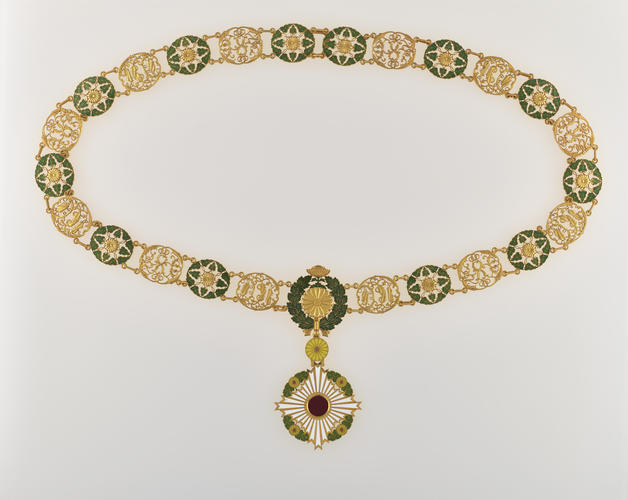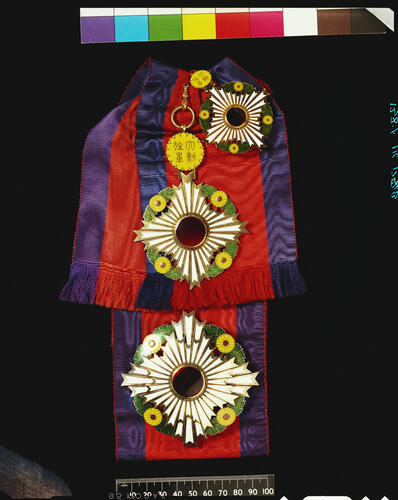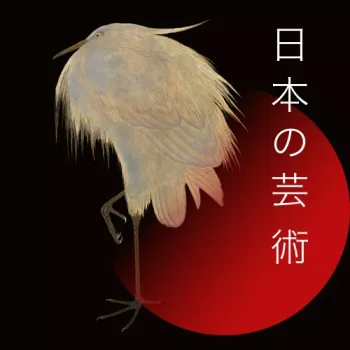Insignia of the Order of the Chrysanthemum (Japan). George V's collar and collar badge c. 1911 - 1918
Gold, enamel, silk, lacquer | 4.5 cm (Width); 82.0 cm (Length) (whole object) | RCIN 441562

Osaka Mint
Master: Insignia of the Order of the Chrysanthemum (Japan). George V's collar and collar badge Item: Order of the Chrysanthemum (Japan). George VI's collar and collar badge c. 1911 - 1918

Osaka Mint
Master: Insignia of the Order of the Chrysanthemum (Japan). George V's collar and collar badge Item: Order of the Chrysanthemum (Japan). George VI's collar and collar badge c. 1911 - 1918



-
Shortly after his restoration to power, the Emperor Meiji established a series of honours and decorations as part of Japan’s adoption and adaptation of the courtly traditions of Europe. Much along the French, Prussian and Russian models, these awards comprised different grades and rules for appointment. The first to be instituted was the Order of the Rising Sun in 1875. The Supreme Order of the Chrysanthemum – Japan’s highest decoration – followed in 1876. Originally, the insignia of this Order comprised only the Grand Cordon (badge and star with sash), but a collar and collar badge were added as an additional, higher honour in 1888. In the same year, three other orders were instituted: the Orders of the Paulownia Flowers, the Sacred Treasure and the Precious Crown. The Order of the Golden Kite, a purely military award, was instituted in 1890.
The insignia of the Order of the Chrysanthemum is presented in a black lacquer box (RCIN 442247.d) lined with gold silk brocade and decorated on the outside with the imperial chrysanthemum mon. Speckled nashiji gold lacquer adorns the underside of the lid, and the whole is tied with magenta silk cords. The badge and star of the Grand Cordon are formed of white enamel rays emanating from a red enamel sun enclosed with chrysanthemum flowers and leaves. The same device is used in a smaller form for the collar badge. The collar itself is composed of chrysanthemum flowers and leaves between gold links bearing the stylised kanji letters ‘mei’ and ‘ji’ for the imperial era of its establishment.
The Order effectively has two grades, with the collar normally reserved for members of the imperial family and reigning foreign monarchs. King Edward VII was appointed to the Grand Cordon when Prince of Wales on 20 September 1886, and the investiture by Prince Komatsu on behalf of the emperor took place at Marlborough House on 7 December that year. He received the collar as king in 1902 and was therefore the first British recipient of either grade. On the same date, Queen Alexandra received the Order of the Precious Crown, both appointments being made on 13 April 1902. After 1886, the Grand Cordon was next bestowed on Prince Arthur, Duke of Connaught during his visit to Japan in May 1890 and to members of the British royal family on six subsequent occasions before 1937.
Appointments to the Order of the Chrysanthemum coincided with royal visits to and from Japan. In particular, they were associated with the missions sent by King Edward VII and King George V to invest the Meiji, Taishō and Shōwa emperors with the Order of the Garter in 1906, 1912 and 1929 respectively. As the king’s representative on two of these Garter missions, Prince Arthur of Connaught received the Grand Cordon in 1906 and then the collar in 1912. Prince Henry, Duke of Gloucester, who had received the Grand Cordon in 1921, received the collar in 1929 when leading the mission to invest the Emperor Shōwa.
Discussions about the exchange of orders had taken place even before the appointment of Albert Edward, Prince of Wales in 1886. When Prince Arisugawa Takehito was to visit Britain in 1880, the Emperor Meiji wished to present Queen Victoria with the Chrysanthemum. It was proposed that, if this took place, a reciprocal award could be made of the Order of the Bath or the Order of the Star of India. However, the former was deemed not suitably distinguished and the latter was seen as a reward for colonial rulers and therefore unsuitable for the emperor. The British appear to have been reluctant to bestow a Christian Order on a non-Christian ruler. This was despite the fact that two Ottoman sultans and the Shah of Persia had received the Garter in 1856, 1867 and 1873 respectively. In the end, it was felt that offering either the Order of the Bath or of the Star of India would result in a lower order than the Chrysanthemum being bestowed on the queen, causing embarrassment to Britain, and so the topic was dropped. The question of reciprocal appointments was not resolved until King Edward VII appointed the Emperor Meiji to the Garter in 1906, following the Anglo-Japanese Alliance.
The investiture of Prince Arthur, Duke of Connaught with the Chrysanthemum in 1906 was of particular significance because he was the first-ever recipient to be invested personally by the emperor. A.B. Mitford recorded that the Emperor Meiji visited the prince at his accommodation following his own investiture with the Garter earlier that day: ‘The Emperor expressed great admiration for the ceremonial … and repeated his sentiments of gratitude to King Edward. Then producing a lacquer box, he took from it the ribbon and star of the Order of the Chrysanthemum and with his own hands put the ribbon over the Prince’s shoulder and pinned the star to his breast’. The investiture passed without incident, whereas during the earlier Garter ceremony the prince had pricked his finger on the pin of the Garter as he buckled it below the emperor’s knee. The mishap drew blood, which stained the decoration. Mitford recalled, ‘The prince, who was only twenty-three, was obviously nervous, but the emperor seemed quite unperturbed.
Text adapted from Japan: Courts and Culture (2020)Provenance
Presented to King George V by Prince Higashi-Fushimi Yorihito, 1911
-
Creator(s)
(maker)(nationality)Acquirer(s)
-
Medium and techniques
Gold, enamel, silk, lacquer
Measurements
4.5 cm (Width); 82.0 cm (Length) (whole object)
5.4 cm (Width); 7.5 cm (Length) (whole object)








